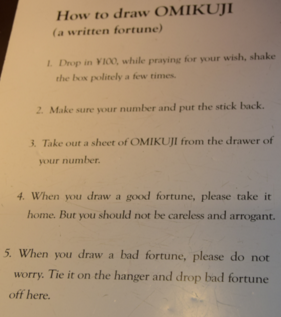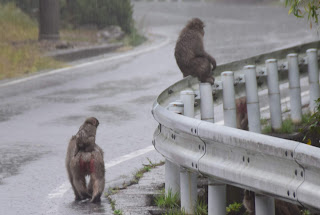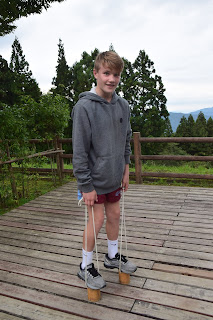For our last day in Tokyo we
opted to obtain an overview of the city and visit Skytree. The weather was
not ideal and below turned out to be the clearest view all day! In the
foreground is a rather bizarre “nose? carrot?....” (you decide) which appears
to be coming out of the side of a high rise. It is in fact a “flame” atop the
lower Asai (beer) headquarters. The flame represents their passion and
dedication to brewing over 100 years.
By the time we ascended the weather had really set in and the view moved from poor to non-existent. After a quick lunch we headed down for a more close up exploration of the nearby Sensoji temple. This Buddhist temple was founded way back in 645.
One area that was attracting
a good deal of attention was a wall with little lockers. For a small fee you
could obtain a written fortune.
The instructions were interesting. If it was good luck take it home - if not then leave it here!
Near the hotel was a street of
restaurants located under the old railway bridge arches. The atmosphere and
variety was hard to ignore and we found ourselves in one called Baden Baden. A
stein of German beer, goulash, and
sauerkraut all in the middle of Tokyo was a little surreal but tasty and
fun.
We then hopped on a
shinkanzen and headed off for Fukuoka (back on Kishu - the southern island) and shuttled to and from Oita for the QFs. Although our mob was now smaller they
were no less enthusiastic and looking forward to seeing the Australia v England
clash albeit with a clear underdog status. The 40:16 defeat was expected and
largely as a result of England’s Australian (ex Brumbies) coach. The second QF
which we watched on the following day was a far more exciting affair with Wales
just scraping over France (who early on were reduced to 14 players) 20:19.
As a break to the
Fukouoka/Oita two hour drive we diverted to a pottery village called Ontayaki.
The village comprises a dozen or so potteries – very much a family affair. The
first step is to ensure the clay is as fine as possible. This is undertaken
using "karausu" which are beams simply rising and falling using water diverted from the
river. The other end has a large pick to pulverise the clay. This is a 24/7 affair. I
assume the villagers must somehow find the erratic thumps soothing, although
how you fall asleep awaiting the next tremor escapes me.
The pottery is turned and then the set out to dry.
Once the initial drying has
occurred they are fired using rising kilns. A fire is lit in the bottom chamber
and the heat flows through the various chambers loaded with pottery until
eventually being exhausted through the chimney at the far end. The length of
the kiln enables more pottery to be fired at the same time and also helps with
achieving hotter temperatures by drawing the air over a greater length.
The whole process is hundreds
of years old but the villagers have developed their own distinctive pattern.
As we meandered back to the expressway the valley
progressively opened up and this view rather typified much of the country. The flow of small paddy fields and pockets of houses/farms running up to the foot of
heavily timbered hills ensured there was not much wasted space!
Our flight back was in the
evening and this gave us time for one last day trip. Nagasaki the site of the second A bomb was an obvious choice. The Memorial park is topped by the Peace statue. It was good to see
another wave of schoolchildren visiting although these had a slightly more
upbeat approach to the service we saw in Hiroshima.
The park incorporated sculptures sent from all over the world. Towards the end was the
Fontana Della Pace (peace fountain) from Italy. Overall the park is not large and you
can see the Peace Memorial in the background.
Inside the nearby museum were
some harrowing stories and memorabilia. Also included was a life sized model of
the bomb with a cutaway outlining how it operated. It was not particularly large in stark contrast to the massive damage it caused.
Throughout Japan there were
origami cranes which are viewed as birds of paradise carrying souls to heaven.
The cranes were used in many designs but none more impressive than this picture.
(Don’t ask – I have no idea of the number of cranes!)
With that we headed back to Fukuoka and the airport. Another
RWC over! Quite one of the more frenetic ones due to the large amount of
travelling but nonetheless very enjoyable. Japan is a fascinating country but
probably best viewed in smaller bites. Highlights – the food and mountains were
wonderful, the streetscapes and overhead cables less so. Most of the people
were terrific and keen to overcome any language challenges. In time the
generation that still holds to Japan being for the Japanese will diminish. Certainly,
there is lots more to see but a return visit may need to wait on countries with a higher priority!














































































